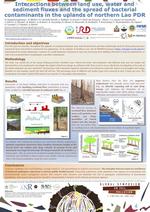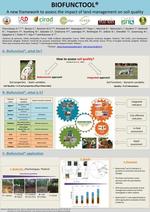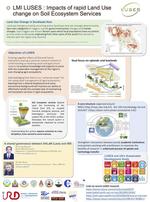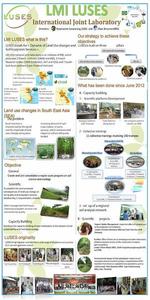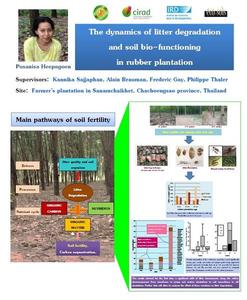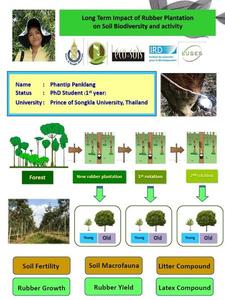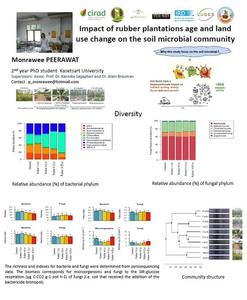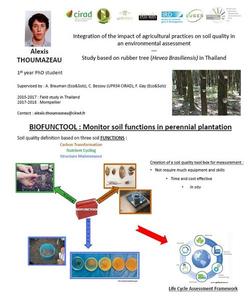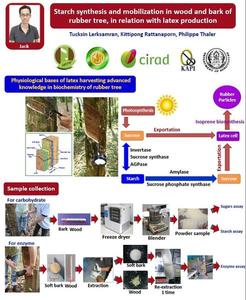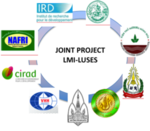BIODIV-TREE: Impact of tree plantations on soil biodiversity and soil biological functioning
BIODIV-TREE: Impact of tree plantations on soil biodiversity and soil biological functioning
BIODIV-TREE aims to characterize the impact of rubber tree plantation on soil functional biodiversity and related soil ecosystems services such as nutrient cycling and C sequestration. Throughout the first phase of LUSES, it has been active in Thailand and Laos, where it has concentrated on rubber tree plantations. The choice of focusing on rubber tree was initially motivated by a strong demand from regional partners to generate new knowledge about the sustainable management of this particular tree species. Indeed, following the rapid rise of latex prices throughout the early 2000s and its climax in 2011, Southeast Asian farmers often supported by government incentives, have massively converted traditional subsistence and commercial agricultural systems, but also vast tracts of forests, to rubber tree plantations. In this context and in view of the regional importance of rubber trees at the time, BIODIV-TREE was designed to address the lack of studies on the environmental consequences of rubber tree plantation on soil ecosystem services. In Thailand, BIODIV-TREE has focused on determining the main drivers (Land Use Change, Tree age, agricultural practices etc.) of changes in soil biodiversity and activities (through field and lab measurements of diagnostic indicators). In Northern Laos, BIODIV-TREE has examined more thoroughly some of the socio-economical determinants and consequences of the expansion of rubber tree plantations.
The work completed under the umbrella of BIODIV-TREE has strengthened the collaboration between IRD and the Hevea Research Platform in Partnership (HRPP) a research platform on natural rubber production and technology that gathers French and Thai scientists, based at Kasetsart University. Studying chrono-sequences BIODIV-TREE showed that plantation age had a stronger influence on the biodiversity and activities of both soil macro- and microfauna, than the land use change corresponding to a conversion from a cassava crop to a rubber tree plantation. This work also showed that conversion from cassava to rubber was concomitant with a relative improvement of soil (bio) functioning, although a reduction in the dynamics of litter decomposition as a function of plantation age was also observed. Further, BIODIV-TREE showed that, beyond land use change, practices, in particular that related to soil management had a profound impact of soil functional diversity and that adjusting practices was a means to improve the impacts of rubber tree cultivation on soil (bio) functioning. Not unexpectedly, this research on the effects of practices showed that intensification reduced the functional diversity of all groups of organisms studied (bacteria, fungi, nematodes, soil fauna), while less intensive practices appeared to maintain more complex food web and support increases in the biomass of all groups of organisms studied. Regarding the work conducting in Northern Laos, BIODIV-TREE found that the production of latex had significantly impacted the livelihoods of households who could produce latex before the very sharp decline of latex prices that followed the 2011 peak, who could such switch from subsistence to semi-subsistence livelihood. However, the more recent collapse of the latex market has had a rather disastrous impact on households who turned to rubber more recently and there is now a new massive and extremely rapid wave of land use change sweeping across in Northern Laos and neighbouring Xishuangbanna in Southern China, and consisting of broad scale conversion of rubber tree plantations to cash crops with high inputs such as banana, most of which destined for the Chinese market.
Overall, BIODIV-TREE demonstrated that rubber tree plantations:
- Contribute, after 12 to 15 years, to rehabilitate highly degraded soils such as that found after successive cycles of cassava, on inherently poorly fertile soils such as that found in Northeastern Thailand;
- Put soil fertility at risk if concomitant with intensive practices, particularly under adverse soil ecological contexts;
- Have a negative impact of soil biodiversity when intercropped with cassava or pineapple;
- Severely affect soil resilience and sustainability after 3 successive cycles (~80 years) of mono-specific plantations;
- Have potential to restore soil carbon contents after an initial phase of soil carbon loss during the establishment of plantations, but at slow rates: typically, soil carbon contents similar to that under previous cassava crop are reached after more than 20 years.
From a methodological perspective, BIODIV-TREE also showed that functional indexes are more reliable indicators of soil ecosystem disturbance than ecological indexes based on taxonomical affiliation. Based on this result, the project launched a new initiative linked to soil indicators so-called BIOFONCT TOOLS. The objective is to produce a composite indicator based on the aggregation of simple indicators related to one of the 3 major soil functions (see table 1) Carbon transformation, Nutrient cycling, Soil structure maintenance. Each of these 3 functions is related to a specific functional assemblage of soil organisms under the influence of abiotic factors (table 1). Hence, the method has to be time and cost-effective while providing reliable, scientifically funded and useful information.
Within the framework of LUSES (2017-2019), the work undertaken by the BIODIV-TREE will be continued and expanded. A large share of the work initiated during the initial phase of LUSES corresponds to PhD projects, which are ongoing. Therefore more data collection and analyses will complement and help refine the first conclusions obtained after the completion of the first phase of the project. In particular, it will be interesting to investigate, as a transversal initiative conducted in conjunction with ECOFILTER, whether the observed loss of soil biological resilience after threes cycles of rubber plantations may be linked to a putative loss of ecological niches as a consequence of the overall impact of such land use on the water balance at the landscape scale, as suggested by some recent work. Further, based on the methodological advances of BIODIV-TREE, the second phase of LUSES will represent an opportunity to (i) validate the biofunctool toolbox (PhD thesis of A. Thomazeau and Mrs Putasso) by applying the box on already characterized rubber tree sites, in order to determine if the toolbox reproduces the trend observed in the phase 1 of the project (ii) further apply the BIOFONCT TOOLS toolbox to various agro-ecosystems subject to land use change.
One obvious research axis that we intend to develop is to assess more precisely the contribution of tree-based systems to below-ground carbon stocks, in particular that corresponding to carbon deposition resulting from root growth deep in the soil, and which might have important implications regarding climate change and climate change mitigation.
Another direction along which BIODIV-TREE will be extended during the second phase of LUSES will be to assess the impacts of tree-based agrosystems other than rubber tree plantations on soil ecosystem services in general and soil functional biodiversity in particular. Specifically, we will target teak tree plantations which have been rapidly expanding across the uplands of Northern Laos and which offer interesting opportunities to develop transversal linkages with ECOFILTER which is also conducted in an environment where conversion of shifting cultivation systems to teak tree plantations is prevailing. Indeed, ECOFILTER showed that the common practice of understorey suppression in teak tree plantations strongly reduces infiltration while increasing runoff, soil erosion and the spread of contaminants. Options to minimize the negative impacts of such practices, such as the introduction of shade tolerant crops with a commercial value (e.g broom grass, cardamom or aromatic plants) represents a potential way to reduce the negative externalities of such systems. At the same time it will be a source of income to farmers, thereby providing an incentive for them to maintain rather than systematically suppress understory vegetation in teak tree plantations. Assessing the soil bio-functioning of these systems would further improve our ability to manage them more sustainably, as it would most likely allow us identifying the most beneficial associations of understory species for maintaining a high level of soil biological activity which is known to be of central importance for soil structure and water infiltration.
Finally, we also propose to expand BIODIV-TREE to high value cropping systems such as of rubber tree agroforestry in Southern Thailand (ANR-Heveadapt project, PhD thesis of Mrs Panglang) and coffee agroforestry plantations (coll. with Chiang Mai University), which have rapidly expanded across parts of Northern Thailand, Southern Laos and Central/Southern Vietnam. Such cropping systems represent unique models to study multi-specific interactions and increase our knowledge about how plant diversity can be used as a means to manipulate soil biological diversity and benefit from feedback effects of soil macro- and microfauna on plant growth and hydro-sedimentary functioning. Practically, partners from the Faculty of Agriculture, Chiang Mai University (CMU) already study such systems in Northern Thailand and have expressed interest in initiating such a research action through their participation in LUSES, thus strengthening LUSES expertise in plant analysis, agroforestry and carbon cycling and soil microbiology (in particular the role of Arbuscular Mycorrhizal Fungi).
LMI LUSES Posters
Presentation of the ECOFILTER Team at the Global Symposium on Soil Pollution (GSOP18), FAO, Rome, 2-4 May 2018
Poster of the BIODIV TREE team presented at the SOM management conference held in Braunsweig on the 30 and 31 of May
Poster of the BIODIV TREE team presented at the SOM management conference held in Braunsweig on the 30 and 31 of May
Synopsis of LUSES 2017-2019
- LDD-IRD a long history of scientific cooperation
- Impact of Rubber Tree Plantation on Soil Biological Diversity
- LDD-LMI LUSES Platform of Microbiology
- LMI LUSES presentation
- PCR LDD-LMI LUSES Platform
- Laboratory guide: hygiene and safety in English
- Laboratory guide: hygiene and safety in Thai
PhDs students' scientific posters
The dynamics of litter degradation and Soil-bio functioning in Rubber plantation : Pusanisa Heepngoen
Long term impact of Rubber Plantation on Soil biodiversity and Activity: Phantip Panklang
Impact of Rubber Plantation age and Land use change on the soil microbial community : Monrawee
Integration of the impact of agricultural practices on soil quality in an environmental assessment : Alexis
Starch Synthesis and Mobilization in wood and bark of rubber tree, in relation with Latex production : Tuksin




